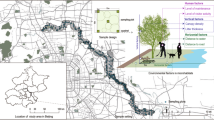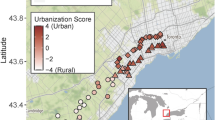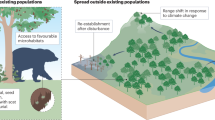Abstract
Spontaneous plants, those not planted by people or remaining from before urbanization, are vital to urban biodiversity. Their distribution in urban systems is affected by seed dispersal mode and environmental factors such as natural dispersal limitation and habitat quality factors. We assessed four seed dispersal modes in 16 cities in Yunnan province, the most biodiverse province in China. Autochory, in which plants eject seeds or otherwise power their seeds’ dispersal, was the dominant seed dispersal mode of urban spontaneous plants in most cities (13 out of 16), whereas hydrochory, or passive seed dispersal by water, was the least frequent. Our research showed spontaneous plants in urban ecosystems adopt convergent strategies to address environmental stressors. The number of urban plants was significantly higher in colder and more-humid climates but decreased with increased dispersal limitations and reduced habitat quality. Sensitivities to these factors varied, with autochory especially sensitive to dispersal limitation and hydrochory sensitive to habitat quality and climate. Findings suggest improving habitat quality and creating green corridors would enhance conservation efforts for urban biodiversity.
This is a preview of subscription content, access via your institution
Access options
Subscribe to this journal
Receive 12 digital issues and online access to articles
$119.00 per year
only $9.92 per issue
Buy this article
- Purchase on SpringerLink
- Instant access to full article PDF
Prices may be subject to local taxes which are calculated during checkout





Similar content being viewed by others
Data availability
The data and codes that support the findings of this study are publicly available via figshare at https://doi.org/10.6084/m9.figshare.27292317.v1 (ref. 67). Original photographs, collection numbers and scanned images of the herbarium specimens created during our study (currently housed at Kunming Institute of Botany) can also be obtained from the corresponding author upon request.
Code availability
The code that supports the findings of this study is available via figshare at https://doi.org/10.6084/m9.figshare.27292317.v1 (ref. 67).
References
Howe, H. F. & Smallwood, J. Ecology of seed dispersal. Annu. Rev. Ecol. Syst. 13, 201–228 (1982).
Dhiman, S. (ed.) Sustainable Development and Environmental Stewardship: Global Initiatives Towards Engaged Sustainability (Springer, 2023).
Niemelä, J., et al. Urban Ecology: Patterns, Processes, and Applications (OUP Oxford, 2011).
Zhang, M. et al. How urban riparian corridors affect the diversity of spontaneous herbaceous plants as pollination and dispersal routes - a case of the Wenyu River- North Canal in Beijing, China. Ecol. Indic. 146, 109869 (2023).
Garrard, G. E., McCarthy, M. A., Vesk, P. A., Radford, J. Q. & Bennett, A. F. A predictive model of avian natal dispersal distance provides prior information for investigating response to landscape change. J. Anim. Ecol. 81, 14–23 (2012).
Damschen, E. I. et al. How fragmentation and corridors affect wind dynamics and seed dispersal in open habitats. Proc. Natl Acad. Sci. 111, 3484–3489 (2014).
Niu, H. et al. Regeneration of urban forests as influenced by fragmentation, seed dispersal mode and the legacy effect of reforestation interventions. Landsc. Urban Plan. 233, 104712 (2023).
Soomers, H. et al. Wind and water dispersal of wetland plants across fragmented landscapes. Ecosystems 16, 434–451 (2013).
Farwig, N., Schabo, D. G. & Albrecht, J. Trait‐associated loss of frugivores in fragmented forest does not affect seed removal rates. J. Ecol. 105, 20–28 (2017).
Niu, H. et al. Granivorous rodent loss poses greater threats to oak trees with large acorns than those with small ones in urban forests. Urban For. Urban Green. 62, 127185 (2021).
Bowler, D. E. & Benton, T. G. Causes and consequences of animal dispersal strategies: relating individual behaviour to spatial dynamics. Biol. Rev. Camb. Philos. Soc. 80, 205–225 (2005).
Gorton, A. J. & Shaw, A. K. Using theoretical models to explore dispersal variation and fragmentation in urban environments. Popul. Ecol. 65, 17–24 (2023).
Piano, E., Bonte, D., De Meester, L. & Hendrickx, F. Dispersal capacity underlies scale‐dependent changes in species richness patterns under human disturbance. Ecology 104, e3946 (2023).
Arrhenius, O. Species and area. J. Ecol. 9, 95–99 (1921).
de Candolle, A. Géographie Botanique Raisonnée ou Exposition des faits Principaux et des lois Concernant la Distribution Géographique des Plantes de l'époque Actuelle, Vol. 2 (V. Masson, 1855).
MacArthur, R. H. & Wilson, E. O. The Theory of Island Biogeography (Princeton University Press, 1967).
Hanski, I. & Gilpin, M. Metapopulation dynamics: brief history and conceptual domain. Biol. J. Linn. Soc. 42, 3–16 (1991).
McDonnell, M. J. & Pickett, S. T. Ecosystem structure and function along urban–rural gradients: an unexploited opportunity for ecology. Ecology 71, 1232–1237 (1990).
Laurance, W. F. Theory meets reality: how habitat fragmentation research has transcended island biogeographic theory. Biol. Conserv. 141, 1731–1744 (2008).
Essl, F. et al. Socioeconomic legacy yields an invasion debt. Proc. Natl Acad. Sci. USA 108, 203–207 (2011).
Hahs, A. K. & McDonnell, M. J. Extinction debt of cities and ways to minimise their realisation: a focus on Melbourne. Ecolog. Manag. Restor. 15, 102–110 (2014).
Tilman, D., May, R. M., Lehman, C. L. & Nowak, M. A. Habitat destruction and the extinction debt. Nature 371, 65–66 (1994).
Gao, Z. et al. Beta diversity of urban spontaneous plants and its drivers in 9 major cities of Yunnan province, China. Landsc. Urban Plan. 234, 104741 (2023).
Di Musciano, M. et al. Elevational patterns of plant dispersal ability in Southern Europe. Plant Biosyst 157, 71–79 (2023).
Prach, K. et al. The role of spontaneous vegetation succession in ecosystem restoration: a perspective. Appl. Veg. Sci. 4, 111–114 (2001).
Qian, S. et al. Urban growth and topographical factors shape patterns of spontaneous plant community diversity in a mountainous city in southwest China. Urban For. Urban Green. 55, 126814 (2020).
Hu, S. et al. Characterizing composition profile and diversity patterns of spontaneous urban plants across China’s major cities. J. Environ. Manage. 317, 115445 (2022).
Huang, L. et al. Masonry walls as sieve of urban plant assemblages and refugia of native species in Chongqing, China. Landsc. Urban Plan. 191, 103620 (2019).
Chang, M. et al. Land-use diversity can better predict urban spontaneous plant richness than impervious surface coverage at finer spatial scales. J. Environ. Manage. 323, 116205 (2022).
Cote, J. et al. Evolution of dispersal strategies and dispersal syndromes in fragmented landscapes. Ecography 40, 56–73 (2017).
Matthies, S. A., Rüter, S., Prasse, R. & Schaarschmidt, F. Factors driving the vascular plant species richness in urban green spaces: using a multivariable approach. Landsc. Urban Plan. 134, 177–187 (2015).
van der Pijl, L. Principles of Dispersal in Higher Plants (Springer, 1982).
Ceplová, N., Kalusová, V. & Lososová, Z. Effects of settlement size, urban heat island and habitat type on urban plant biodiversity. Landsc. Urban Plan. 159, 15–22 (2017).
Cruz, J. C., Ramos, J. A., Da Silva, L. P., Tenreiro, P. Q. & Heleno, R. H. Seed dispersal networks in an urban novel ecosystem. Eur. J. For. Res. 132, 887–897 (2013).
Wilson, M. C. et al. Assessing habitat fragmentation’s hierarchical effects on species diversity at multiple scales: the case of Thousand Island Lake, China. Landsc. Ecol. 35, 501–512 (2020).
Lososová, Z. et al. Seed dispersal distance classes and dispersal modes for the European flora. Glob. Ecol. Biogeogr. 32, 1485–1494 (2023).
García-Palacios, P., Gross, N., Gaitán, J. & Maestre, F. T. Climate mediates the biodiversity–ecosystem stability relationship globally. Proc. Natl Acad. Sci. USA 115, 8400–8405 (2018).
Wheeler, M. M. et al. Continental-scale homogenization of residential lawn plant communities. Landsc. Urban Plan. 165, 54–63 (2017).
Vakhlamova, T., Wagner, V., Padullés Cubino, J., Chytrý, M. & Lososová, Z. Urban plant diversity in Kazakhstan: effects of habitat type, city size and macroclimate. Appl. Veg. Sci. 25, e12679 (2022).
Ouyang, Y. et al. Homogenization of trees in urban green spaces along the moisture gradient in China. Urban For. Urban Green. 83, 127892 (2023).
Padullés Cubino, J. et al. Drivers of plant species richness and phylogenetic composition in urban yards at the continental scale. Landsc. Ecol. 34, 63–77 (2019).
Aronson, M. F. J. et al. A global analysis of the impacts of urbanization on bird and plant diversity reveals key anthropogenic drivers. Proc. R. Soc. B 281, 20133330 (2014).
Gao, Z. et al. Drivers of spontaneous plant richness patterns in urban green space within a biodiversity hotspot. Urban For. Urban Green. 61, 127098 (2021).
Kalusová, V. et al. Similar responses of native and alien floras in European cities to climate. J. Biogeogr. 46, 1406–1418 (2019).
Clark, J. S. Statistical Computation for Environmental Sciences in R: An Introduction (Princeton University Press, 2007).
Yunnan Yearbook Editorial Committee (ed.) Yunnan Yearbook (Yunnan Yearbook Editorial Press, 2019).
Zomer, R. J., Xu, J., Wang, M., Trabucco, A. & Li, Z. Projected impact of climate change on the effectiveness of the existing protected area network for biodiversity conservation within Yunnan Province, China. Biol. Conserv. 184, 335–345 (2015).
Zhu, H. & Tan, Y. Flora and vegetation of Yunnan, Southwestern China: diversity, origin and evolution. Diversity 14, 340–358 (2022).
Myers, N., Mittermeier, R. A., Mittermeier, C. G., Da Fonseca, G. A. & Kent, J. Biodiversity hotspots for conservation priorities. Nature 403, 853–858 (2000).
Grande, T. O., Aguiar, L. M. & Machado, R. B. Heating a biodiversity hotspot: connectivity is more important than remaining habitat. Landsc. Ecol. 35, 639–657 (2020).
Qian, L., Chen, J., Deng, T. & Sun, H. Plant diversity in Yunnan: current status and future directions. Plant Divers 42, 281–291 (2020).
Guo, Z. & Zheng, J. Predicting modes of seed dispersal using plant life history traits. Biodivers. Sci. 25, 966–971 (2017).
Yu, X., Li, Y. & Yang, G. Fruit types and seed dispersal modes of plants in different communities in Shilin Geopark, Yunnan, China. Chin. J. Plant Ecol. 42, 663–671 (2018).
ArcGIS 10.3.1 (Esri, 2015).
Zhong, X. Y., Yan, Q. W. & Li, G. E. Development of time series of nighttime light dataset of China (2000–2020). J. Glob. Change Data Discov. 3, 416–424 (2022).
Zhao, N., Liu, Y., Cao, G., Samson, E. L. & Zhang, J. Forecasting China’s GDP at the pixel level using nighttime lights time series and population images. GISci. Remote Sens. 54, 407–425 (2017).
Yang, J. & Huang, X. The 30 m annual land cover dataset and its dynamics in China from 1990 to 2019. Earth Syst. Sci. Data 13, 3907–3925 (2021).
Bates, D. et al. lme4: mixed-effects models in R. R package version 1.1-35.1. GitHub https://github.com/lme4/lme4/ (2009).
Menard, S. Applied Logistic Regression Analysis (Sage, 2002).
Vittinghoff, E., Glidden, D. V., Shiboski, S. C. & McCulloch, C. E. Regression Methods in Biostatistics: Linear, Logistic, Survival, and Repeated Measures Models (Springer, 2012).
James, G., Witten, D., Hastie, T. & Tibshirani, R. An Introduction to Statistical Learning: with Applications in R (Springer, 2013).
Hartig, F. DHARMa: residual diagnostics for hierarchical (multi-level/mixed) regression models. R package version 0.4.6. GitHub http://florianhartig.github.io/DHARMa/ (2020).
Lenth, R., Singmann, H., Love, J., Buerkner, P. & Herve, M. Package ‘emmeans’. R package version 1.10.1. GitHub https://rvlenth.github.io/emmeans/ (2019).
Anderson, D. & Burnham, K. Model Selection and Multimodel Inference (Springer, 2004).
Gross, N. et al. Functional trait diversity maximizes ecosystem multifunctionality. Nat. Ecol. Evol. 1, 0132 (2017).
R Core Team. R: A Language and Environment for Statistical Computing (R Foundation for Statistical Computing, 2023).
Gao, Z. Response and sensitivity of urban plants with different seed dispersal modes. figshare https://doi.org/10.6084/m9.figshare.27292317.v1 (2024).
Acknowledgements
We thank X. Yu from Qiannan Normal University for Nationalities for helping with the species identification. This research was funded by Major Program for Basic Research Project of Yunnan Province (L.D., 202101BC070002), the Ministry of Science and Technology of China (L.D., 2015FY210200), ECNU Academic Innovation Promotion Program for Excellent Doctoral Students (Z.G., YBNLTS2019), and the National Key Research and Development Program of China (Y.P., 2023YFF1305800). Y.P. acknowledges the funds from the Chinese Academy of Sciences (E429S10101) and the Innovation Team Project of Northeast Institute of Geography and Agroecology, Chinese Academy of Sciences (2023CXTD03).
Author information
Authors and Affiliations
Contributions
Z.G.: field survey, data collection, analysis, interpretation and drafting the manuscript; Y.Y., T.W., M.Z., T.X., Y.H.: field survey, collecting data and revising the manuscript; E.C., K.S. and Y.P.: data analysis, interpretation of data, conception and revising the manuscript critically; K.S. and L.D.: funding, conception, revising the manuscript and final approval of the manuscript. All authors have read and agreed to the published version of the manuscript.
Corresponding author
Ethics declarations
Competing interests
The authors declare no competing interests.
Peer review
Peer review information
Nature Cities thanks Ádám Lovas-Kiss, Rafael Zenni and the other, anonymous, reviewer(s) for their contribution to the peer review of this work.
Additional information
Publisher’s note Springer Nature remains neutral with regard to jurisdictional claims in published maps and institutional affiliations.
Supplementary information
Supplementary Information
Supplementary Tables 1 and 2.
Supplementary Code 1
Supplementary code.
Supplementary Data 1
Data for Sankey diagram.
Supplementary Data 2
Data for interaction model.
Supplementary Data 3
Data for separate models.
Supplementary Data 4
Data of species list.
Rights and permissions
Springer Nature or its licensor (e.g. a society or other partner) holds exclusive rights to this article under a publishing agreement with the author(s) or other rightsholder(s); author self-archiving of the accepted manuscript version of this article is solely governed by the terms of such publishing agreement and applicable law.
About this article
Cite this article
Gao, Z., Pan, Y., Song, K. et al. Response and sensitivity of urban plants with different seed dispersal modes. Nat Cities 2, 28–37 (2025). https://doi.org/10.1038/s44284-024-00169-8
Received:
Accepted:
Published:
Issue date:
DOI: https://doi.org/10.1038/s44284-024-00169-8
This article is cited by
-
The effects of urbanization on species richness and floristic diversity in residential gardens
Urban Ecosystems (2025)



